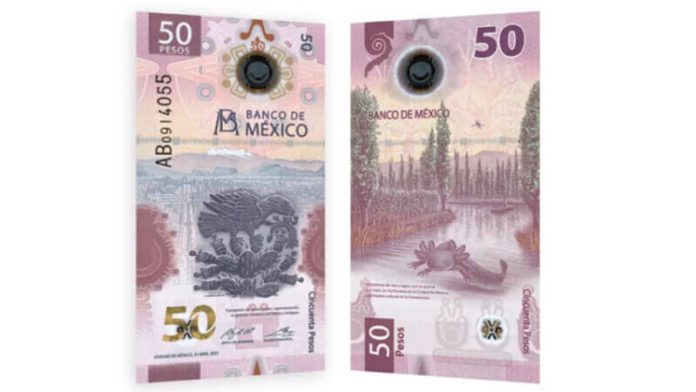A new 50-peso bill featuring the Mexica capital of Tenochtitlán on one side and an axolotl on the other is now in circulation.
The Bank of México announced Thursday that the newest member of the new family of banknotes had been released. The central bank had previously issued new 500, 200, 100 and 20-peso bills.
In the foreground of the obverse side of the new, purple-colored polymer 50-peso note is an image of the rear view of the Teocalli of the Sacred War, a stone miniature of a Mexica, or Aztec, temple that was carved on the orders of Moctezuma II, the tlatoani, or ruler, of Tenochtitlán when the Spanish arrived in the early 16th century.
The rear side of the pre-Hispanic monolith, which is on display at the National Museum of Anthropology in Mexico City, features an eagle perched on a nopal, or prickly pear cactus, with an Atl tlachinolli in its beak. An Atl tlachinolli is a Mexica symbol of water and fire, or war.
Below the image of the monolith appear the words: “Foundation of Tenochtitlán, representing the historical period of old Mexico.”
In the background of the obverse side is a representation of Tenochtitlán based on a section of a mural by Diego Rivera, the acclaimed 20th century Mexican artist.
Tenochtitlán, upon which Mexico City was built, means “place where prickly pears abound” in Náhuatl. It was founded by the Mexica people in 1325 on an island located on Lake Texcoco. The legend goes that they decided to build a city on the island because they saw the omen they were seeking there: an eagle devouring a snake while perched on a nopal.
The reverse side of the new 50-peso bill features an axolotl, a species of salamander endemic to the waterways of the Mexico City borough of Xochimilco. In the background are chinampas, or floating gardens, where corn is being grown, ahuejotes, or native willow trees, and a boat on the surface of a Xochimilco canal.
A dragonfly hovers above the axolotl, known in Mexico as an ajolote. Below it appear the words: “Ecosystem of rivers and lakes, with the ajolote and corn in Xochimilco in Mexico City, World Heritage site.”
The new note also features a transparent window in the form of an Ollin, a Mexica symbol representative of movement. In addition, it has a range of other security features that make it difficult to forge, as well as raised text that can help blind and visually impaired people identify it.
Mexico News Daily
